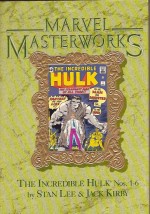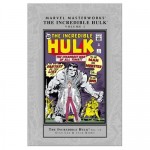

By Stan Lee, Jack Kirby, Steve Ditko & various (Marvel)
ISBN: 0-87135-594- 9Â Â second edition: 978-0785111856
Coming out of a monster comics mini-boom and well aware of the fact that everybody loves a terrifying titan, Stan Lee and Jack Kirby didn’t look too far afield or take massive risks when they were looking to capitalise on the burgeoning success of their radical new comic Fantastic Four.
The Incredible Hulk was Marvel’s second superhero title, although technically Henry Pym debuted earlier in a one-off yarn in Tales to Astonish #27 (January 1962), but he didn’t become costumed hero Ant-Man until the autumn, by which time Ol’ Greenskin was not-so-firmly established.
The Hulk crashed right into his own comicbook and after some supremely exciting exploits by Young Marvel’s finest creators, crashed right out again. After six bi-monthly issues the series was cancelled and Lee retrenched, making the character a perennial guest-star in other Marvel titles (Fantastic Four #12, Amazing Spider-Man #14, The Avengers from #1- first as a member then a recurring foe) until they found a way to rekindle the drama in their new “Split-Book†format.
Cover-dated May 1962 The Incredible Hulk #1 introduced physically unprepossessing atomic scientist Bruce Banner, sequestered on a secret military base in the desert, perpetually bullied by bombastic commander General “Thunderbolt†Ross as the hours and minutes slipped away before the World’s first Gamma Bomb test.
Besotted by Ross’s daughter Betty, Banner endured the General’s constant jibes as the clock ticked on and tension increased even while his abrasive assistant Igor constantly cajoled him for keeping the details of the G-Bomb secret.
During the final countdown Banner saw a teenager drive into Ground Zero and frantically dashed to the site to drag the boy away. Unknown to him the Igor, who has been ordered to delay the countdown, has an agenda of his own…
Rick Jones was a wayward but good-hearted kid. After initial resistance he lets himself be dragged into a safety trench, but just as Banner was about to join him The Bomb detonated…
Miraculously surviving the blast Banner and the boy were secured by soldiers, but that evening as the sun set the scientist underwent a monstrous transformation. He grew larger; his skin turned a stony grey…
In six simple pages that’s how it all started and no matter what any number of TV or movie reworkings, comicbook retcons and psycho-babble re-evaluations would have you believe it’s still the best and most primal take on the origin. A good man, an unobtainable girl, a foolish kid, an unknown enemy and the horrible power of destructive science unchecked when the sun set and darkness fell…
Written by Stan Lee, drawn by Jack Kirby with inking by Paul Reinman, ‘The Coming of the Hulk’ barrels along as the man-monster and Jones are kidnapped by Banner’s Soviet counterpart the Gargoyle for a rousing round of espionage and Commie-busting before simple humanity saved the day and returned the heroes to their own, less than friendly shores.
In the second issue the plot concerned invading aliens – a staple of Early Marvel Tales – and the Banner/Jones relationship settled into a traumatic nightly ordeal as the scientist metamorphosed and was summarily locked into an escape-proof cell whilst the boy stood watch helplessly. Neither considered for a moment telling the government of their predicament…
‘The Terror of the Toad Men’ was formulaic but viscerally and visually captivating as Steve Ditko inked Kirby, imparting a genuinely eerie sense of sinister unease to the artwork as grotesque invaders conquered Earth only to be repelled at the last moment by Banner – not the Jade Juggernaut. Incidentally, this is the story where the Hulk inexplicably developed his more accustomed Green tan.
Although back-written years later as a continuing mutation, the plain truth is that grey tones caused all manner of problems for the production colourists so it was arbitrarily changed to the simple and more traditional colour of creatures.
The third issue presented a departure in format as the full-length, chaptered epics gave way to complete short stories. Dick Ayers inked Kirby in the transitional ‘Banished to Outer Space’ which radically altered the relationship of Jones and the monster after the rampaging Hulk was rocketed into orbit where radiation created a mental link between boy and beast. Moreover the Hulk was now able to emerge even in daylight from there on…
The story thus far was reprised in a three-page vignette ‘The Origin of the Hulk’ and that Marvel mainstay of malice the Circus of Crime debuted in ‘The Ringmaster’ – a riotous romp of brute strength and inspired larceny.
After a double-image cover which presaged those aforementioned split-books, the Hulk went on an urban rampage in #4’s first tale ‘The Monster and the Machine’ and Rick began using a colossal cyclotron to forcibly change the beast back into Banner whilst aliens and Commies combined in unlikely fashion with the second adventure ‘The Gladiator from Outer Space!’
The Incredible Hulk #5 was a joyous classic of primal Kirby action; introducing the immortal despot Tyrannus and his subterranean empire in ‘The Beauty and the Beast!’ whilst those pesky commies came in for another drubbing when our Jolly Green freedom-fighter travelled to the East to counter the invasion of Lhasa by ‘The Hordes of General Fang!’
Despite the sheer verve and bravura of these stripped-down, simplistic classics – some of the purest most exhilarating and rewarding comics nonsense ever produced – the series was not selling and Kirby was moved on to more appreciated arenas. Steve Ditko handled the art chores for #6, which returned to a full-length epic – and an extremely engaging one. ‘The Incredible Hulk Vs the Metal Master’ involved an invasion by an alien who could mentally manipulate minerals, alloys and processed metal and almost made Earth his own. Combining superb action, sly and subtle sub-plots, tragedy, mystery and a sublime thinking man’s resolution, it was nonetheless the final issue.
After shambling around the nascent Marvel universe for a year or so, usually as a misunderstood villain-cum-monster, the Emerald Behemoth got another shot at the big time and eventually found a home in Tales To Astonish where Ant-Man/Giant-Man was rapidly proving to be a character who had outlived his time.
The rest is history…
These immortal epics are available in numerous formats (including softcover editions of the luxurious deluxe hardback under review here), but for a selection that will survive the continual re-readings of the serious, incurable fan there’s nothing to beat the substantial full-colour feel of these Marvellous Masterwork editions.
© 1962, 1963, 1989, 2003 Marvel Characters, Inc. All Rights Reserved.
